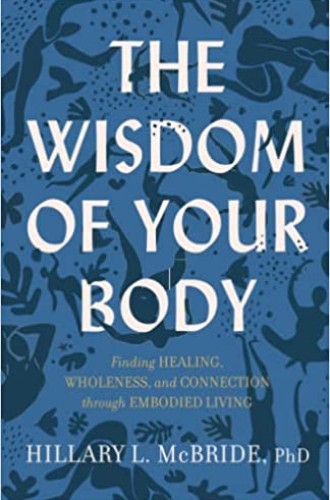Trauma and embodiment
Hillary McBride draws on psychology and theology to encourage us to befriend our bodies.
“Let me begin by saying that I came to theory because I was hurting,” writes bell hooks, who died recently, at the beginning of “Theory as Liberatory Practice,” her groundbreaking essay that became a chapter in Teaching to Transgress. “I came to theory desperate, wanting to comprehend—to grasp what was happening around and within me.” I read those lines 20 years ago, in graduate school, and they felt like a revelation. While I don’t remember exactly why they resonated so much with me, a young White woman with a surplus of privilege and a dearth of hurt, I could not stop thinking about them. The idea that theorizing about our circumstances could be a “location for healing” seemed radically hopeful and entirely new.
Hillary McBride’s academic interest in embodiment was fueled by pain—in her case, disordered eating, allergies, and two car accidents in short succession. Writing with a measure of chagrin about the fact that her research grew out of her own experience as a White woman struggling with body image, she says she eventually “started to see how my body was not only hurting because of oppressive systems; it was also benefiting from them.” A psychologist specializing in trauma therapy, McBride has schooled herself in macro-level understandings of how systems rank bodies, of all the isms that act on bodies in different but interlocking ways. The result is a book that is exceedingly nuanced and elegantly written, if also at points self-conscious.
Read our latest issue or browse back issues.
Embodiment as a term can tip toward the realm of jargon, and before reading this book, I was on the verge of dismissing it. Everyone from theologians to influencers is talking about embodied living; there’s even something called “embodied marketing.” I sometimes wonder whether embodiment discourse is so yoked to privilege that it can’t exist outside of 5Rhythms classes and integrative embodiment retreats in the Berkshires.
However, womanist and other liberation theologies have been foregrounding embodiment for a long time, and recent books like Sonya Renee Taylor’s The Body Is Not an Apology are reclaiming the embodiment conversation from marketers and high-end resorts. Now McBride’s precise definitional work—put simply, she says, embodiment is “the experience of being a body in a social context”—gives important shape to the word, while her clinical experience and authority as a researcher set this book apart from commercials and Instagram manifestos.
McBride is a wise guide and theologically informed companion, one who will help readers befriend their bodies and discover the goodness of experiencing the world fully in them. She pulls together scholarly research, therapeutic strategies, and narrative rooted in her own and others’ experiences of bodies, giving particular attention to the “questions, struggles, and delights of what it means to be human—to be a body in this time and place.” Learning embodiment, she says, “requires curiosity, attention, sensation, and acceptance, which then allows us to develop a healthier and more stable relationship with our body as a whole.” Throughout the book she offers a wellspring of insight from psychology, spirituality, and cultural studies, along with practices for embodiment. These include grounding and orienting techniques, interoception practices, mindfulness, and self-compassion.
For readers who come to this book, in hooks’s words, “desperate, wanting to comprehend,” there is much in its pages—especially in McBride’s end-of-chapter prompts and practices. She offers theoretical passages in such an accessible way that you might not notice the seam of scholarship running underneath. There are fascinating sections, for example, about moving up your stress response staircase, understanding the five circles of sexuality, and learning the three forms of inhibitory affects.
In a chapter on the body and oppression, McBride recounts conversations with others about their experiences of being bodies, including an Indigenous woman, a Black gay man, a queer Asian American woman, and a trans person who self-identifies as fat. One conversation partner, Malcolm, describes the sensation of being a gay Black man in spaces that aren’t affirming of his body as “like a constant hum or a buzz in my ear or inside of me.” And that hum may be more than metaphorical. “Our brains and nervous systems process verbal, social, political, and physical injury in the exact same way,” McBride writes. Elsewhere she describes epigenetic changes that can occur as the result of personal or widespread cultural trauma.
One of McBride’s images that is already changing me is her metaphor of a house. Living in an embodied way means making a home in the body you inhabit rather than standing in the front yard, which is where many of us have been parked: analyzing, comparing landscaping, and commenting on facade and upkeep. We begin our lives dwelling inside: people’s memories of childhood often include a sense of being fully in their bodies. But over time we learn that we have a “public body—that other people comment on, celebrate, use, grab, or critique.” Learning embodiment, then, means stepping back into “the home that has always been ours.”
Self-objectification is so prevalent, McBride writes, that when she tells people she speaks and writes about the body, “most people think I’m talking about appearance.” Research shows that “the majority of us—up to 90 percent of those of us in Western culture and in communities touched by globalization, inclusive of women and men—loathe our bodies.” Her first book was focused on body image, mothers, and daughters. The gift of this book to readers is its immense breadth of topic and depth of analysis. Appearance shows up as only one topic among others, including pain, oppression, sensuality, stress, and trauma.
McBride describes her own experience of having developed PTSD after two car accidents within the course of two months, and she writes movingly about the body in pain: “Our bodies are telling the stories we have avoided or forgotten how to hear.” She suggests we try to speak lovingly to our bodies—as in, out loud. This move—from “treating the body as an object (a thing) to treating the body as a subject (a person)”—is central to her project. McBride ends the book with a letter to her body, with an invitation to readers to write their own. It’s a lovely epilogue, full of apologies to her body and appreciation for all the things it does. “When you show lines and marks, it will be the storybook of what I have lived,” she writes. “I feel full of wonder and appreciation.”
McBride says that Western dualistic thinking has us thinking we have bodies. She hopes her book will help readers discover what she calls an essential truth: “we are our bodies.”
But are we, really? It’s an idea that has a lot of traction these days, but I confess that I am not entirely convinced.
I heartily agree with McBride and others who maintain that something needs to be done about the binary created by the particular blend of settler colonialism and Christianity that maintains a hierarchy of mind over body and of certain bodies over others, as well as the convenient departure of some souls to heaven and other souls to hell. The Western mind-body divide has had disastrous consequences for individuals and cultures alike, especially those with their literal “backs against the wall,” as Howard Thurman writes.
Yet McBride’s claim—that we are our bodies—seems to merely move from one pole of the mind-body split to the other. To have a body or to be one: Are these truly our only options? And tracing various oppressions back to dualism alone seems facile. Wouldn’t White people have figured out ways to dehumanize and enslave Black and Indigenous people without Descartes? Do settlers, colonizers, and men need Plato to justify their supremacies?
I’m not a philosopher or psychologist, and I don’t pretend to understand the harmful legacies of Cartesian dualism on all manner of things, from our body image to our body politic. But the claim that we are our bodies strikes me as reductive, especially in the face of suffering. As a daughter-in-law who sometimes helps a 96-year-old woman use the toilet, I believe both that my mother-in-law’s body is good and that her self transcends her current frailty. As a friend to someone whose brittle bone disease confines his body to a wheelchair, I believe that he is both a body made in God’s image and a holy soul who spills beyond it. McBride’s injunctions—“Try repeating after me: I am my body,” and “Your body is . . . indistinguishable from your self—the two cannot be disentangled”—may not be a healing balm for everyone.
The book does not include chapters on aging or disability, and McBride’s chapter on pain speaks mostly to injury and interrupting the pain cycle; thus I am quarreling with a line of argument she does not fully craft. And the belief that, as she puts it, “the body is not something you have but something you are” has birthed a host of worthy and liberating ideas. Still, that claim may itself become a totalizing narrative, and one that reckons inadequately with debility.
McBride clarifies that the idea that we are our bodies is not intended to “further overidentify each of us with the ways our bodies have been made objects.” But readers may need more support in that regard. How does the idea that “you are your body” not lead to the very thingification that we’re trying to avoid? When do aphorisms intended to refute prevailing wisdom become so widely adopted as to become, well, prevailing wisdom?
McBride’s penultimate chapter, on the holiness of the flesh, allows her to smooth out the reductive edges of her own argument. Having spent most of the book writing in a register that will appeal to anyone, in this chapter she plumbs the potential of Christ’s incarnation to help us become more embodied, the connections between the Spirit and breath, and the truth that God is both transcendent and immanent. The apostle Paul might not have been as much of a dualist as he has been made out to be, McBride writes; what Paul perhaps intended to say, in all his disputations on the flesh and the spirit, was simply that “the body is central to God’s plan for being in the world.”
It is difficult, bell hooks writes, to “name our pain, to make it a location for theorizing.” In the end, McBride helps readers do just that. Her book issues a lyrical invitation to fuller awareness of our bodies and the world they inhabit, calling us to name the untruths we’ve been taught and to become more sensual, sensing beings. In the words of James Baldwin in The Fire Next Time, to be sensual—to be embodied—means “to be present in all that one does, from the effort of loving to the breaking of bread.” For all of us who sail through the day distracted, disconnected, and disembodied, those are efforts of love worth making.
A version of this article appears in the print edition under the title “Befriending our bodies."






